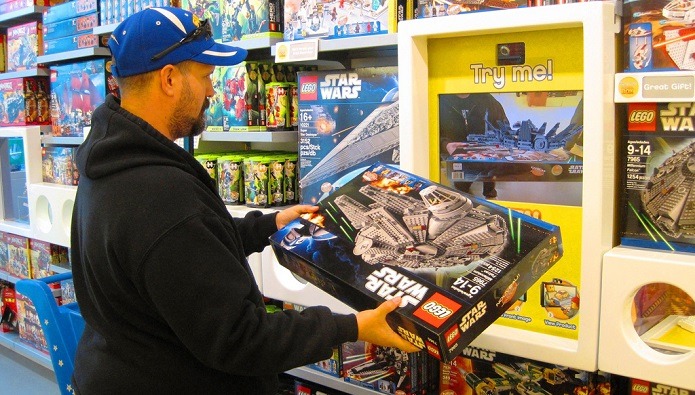Secret Retail Tricks Finally Exposed (and How to Avoid Them!)
“If someone tries to sell you something with a brain in it … ask to see the evidence. Ask for the part of the story that’s not being told.” — Molly Crockett
The next time you walk into a store take a second and look around. Look at how the products are displayed, where they are located on the shelf, and the words used to describe stuff that is supposedly on sale. It’s all done in a way to trick your brain in one way or another. Either to fill it with “warm and fuzzies” so you’ll buy, or to make you think you’re getting a great deal regardless of whether you actually are or not.
They say mold can’t grow in the sunlight. So today I want to expose these dirty little retail tricks to the light of day once and for all. Plus, I want to give you some tips on how to avoid them altogether.

1. Words, Words, Everywhere Words
It is no secret that retailers use psychologists all the time to figure out what words and images will trigger our brains to pull out our hard earned money and buy.
Popular phrases like “Lowest Price”, “Special Value”, “Limited Time Only”, “Unbeatable Price”, and “As Advertised” are plastered all over the store to make you think you’re getting a great deal.
A product could have a cute little sign by it saying “Lowest Price” when in actuality that’s the price it is always at.
The same can be said for “Unbeatable Price”, yeah it probably never can be beaten because the price will never be lowered.
But my favorite is “As Advertised”. So just because you included this product in your weekly flier it must be on sale? Yeah right, not falling for that one.
Ignore the signs and fliers and banners in the store, they often don’t mean squat.
Instead do your own independent research, especially on bigger ticket items, and make sure you’re actually getting a product that is on sale.
The easiest way to do this is at home with a price comparison website (PriceGrabber.com is my favorite) or do your research in the store with a free price comparison app on your smartphone (ShopSavvy is my favorite).
2. The Game of 3
Have you ever been in a store, especially consumer electronic stores, and you see 3 quite similar products with 3 different price points?
One priced high, one low, and one priced right in the middle.
Typically, this is not done by accident.
Stores have done the research and they know that consumers tend to gravitate to the product priced in the middle, figuring the lowest is cheap and of poor quality, and the higher priced one is a rip-off.
They do this because the middle priced item is where they make their money and where their profits are highest.
The next time you notice this retail strategy look closely at the differences between the lowest priced item and the middle, typically there is very little difference making the lowest priced item your BEST buy.
This is especially true with HDTV’s, Blu-ray players, video cameras, and digital cameras.
3. “Bait” Products
You’ll see this trick a lot in apparel, shoe, and clothing stores.
Basically it is when the Men’s Wearhouse has a $800 suit on display right next to a rack filled with $350 suits.
Truth be known, in many cases the $800 suit is nothing more than bait to make you think the $350 suit is a great value for the money.
Stores often never expect to sell the $800 suit.
Don’t let your brain play tricks on you!
Walk into a store knowing exactly what you expect to pay and only buy if the price fits your budget and not just because it appears to be a good deal.
In all likelihood the $350 suit will be on sale for $199 in a couple weeks.
4. Price Tag Game
If you’re a loyal reader here at Rather-Be-Shopping.com, you already know that I cracked the price tag code earlier this year.
While the last 2 digits of the price tag can indeed indicate a closeout or clearance product at certain retailers, in many cases it is simply a trick to make you think you’re getting a screaming deal.
Most people see a price ending in .99 and they think it is full retail price and when they see a funky number like .97, .28, or .73 they tend to think it must be a markdown price.
This is often not the case and done simply to make you think that.
Walmart is notorious for this as they often have some very strange prices.
They want you to think that they have a bunch of eggheads at Walmart HQ crunching the numbers trying to come up with the rock bottom price that they can sell it to you for.
While sometimes this is the case, it isn’t always, so be sure to do your homework ahead of time so you know if the price is right or simply a decoy to avoid.
Ask the Reader: Have you ever been tricked by any of these retail secrets? If so, how did you avoid them the next time they presented themselves?

By Kyle James
Photo by Intel Free Press.
I started Rather-Be-Shopping.com in 2000 and have become a consumer expert and advocate writing about out-of-the-box ways to save at stores like Amazon, Walmart, Target and Costco to name a few. I’ve been featured on FOX News, Good Morning America, and the NY Times talking about my savings tips. (Learn more)
